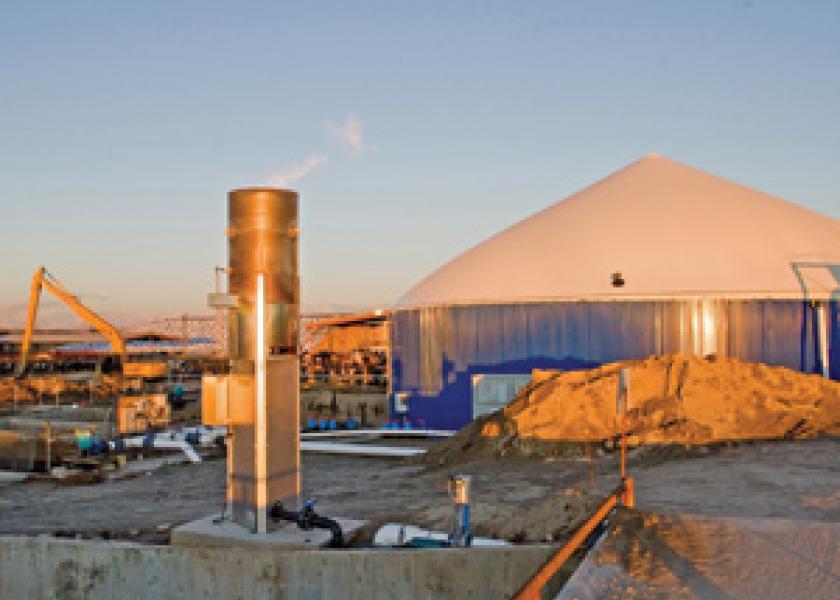Needed: More Digesters

Lack of incentives holds back development
They are some of the dairy industry’s anaerobic digester pioneers, the inno-vators who have taken steps—no, leaps—to create renewable energy, improve manure management, produce cow bedding or simply lessen their dairy’s environmental footprint by reducing air emissions and odor.
Despite their varied and sometimes difficult digester experiences, all eight members of a panel discussion at World Dairy Expo last month remain advocates of biogas production. AgSTAR, a division of the U.S. Environmental Protection Agency, sponsored the session, called "Straight from Producers: The Real Story on Anaerobic Digestion Systems."
Currently, there are 138 methane digesters operating on dairy farms in 26 states. That relatively small number compares to the more than 3,300 herds with 500 or more cows, and the 1,650 herds with 1,000 or more cows. Depending on the digester’s size and scale, many of these herds could be candidates for methane production.
Bonus Content |
| More about digesters:
|
The producers on the panel were united in their call for a national energy policy that includes more support for manure-generated energy. "Biogas has far more to add to the national energy grid than wind or solar," said panel member John Vrieze, who has built two digesters north of Baldwin, Wis., since 2005.
"I’ve been a fan of renewable energy for 15 years," Vrieze said. "But it’s going to take more regulatory or economic incentive for power companies to participate with dairies. Too many electric cooperatives don’t cooperate."
Vrieze thought he would reap income from turning his dairy’s biogas into natural gas. But, to his disappointment, natural gas has fallen from $10/kwh to $3. Now his first digester’s biggest benefit is the manure-based bedding it turns out, while his second digester merely provides heat for a nearby greenhouse.
A policy change or more incentive is needed to build more digesters and ensure their viability, said Mark Jacobs of Green Valley Dairy in Krakow, Wis., who put his second digester into production 10 months ago. "Making biogas is no longer a technical challenge," he said. "But more resources are needed. We have a policy problem."
"Environmentally, there are lots of good reasons to build digesters," said Lee Jensen of Chippewa Falls, Wis. "But building a digester has to be economically feasible. It can be expensive. If you don’t have the equity, you might be better off with more cows or paying down debt."
In 2005, Jensen became one of the first U.S. dairy producers to join with a manufacturer to build an onsite digester. Jensen’s Five Star Dairy also struck an agreement to sell the digester’s biogas to a local energy utility.
But Jensen’s road to renewable energy hasn’t been easy. The digester manufacturer, Microgy, declared bankruptcy last year. Another company has taken over the digester’s operation, and Jensen said his digester "hasn’t missed a beat." Even so, the six-year-old project has involved "learning, learning, learning," he said.
Glad he built his digester, Jensen sees the potential for many more biogas systems in the U.S. "We could produce more gas, but there’s no incentive without a market," he said. "If our power rates were [as high] as they are in Europe, digesters would be all over."
Karl Crave of Crave Brothers Farm, whose family’s Waterloo, Wis., complete-mix digester became operational in 2007, also thinks a policy change or more incentive is needed. "Vermont’s the only state that’s doing a good job [with digester incentives]," Crave said.
Perhaps no panel comment struck home more than one from Mike Geerlings, who, in 2006, built Michigan’s first dairy digester at his Scenic View Dairy.
"This country would have been better off if all that Solyndra money had gone to digester development instead," Geerlings said. "Solar and wind don’t compare with biogas in cost-per-kilowatt return."
(Earlier this fall, the U.S. Department of Energy provided a $535 million taxpayer loan guarantee to the solar firm Solyndra, which has since declared bankruptcy.)
Renewable energy from wind is only 30% efficient, Geerlings said, while dairy digesters—which operate and produce 365 days a year—offer 90% efficiency. But that fact doesn’t seem to mean very much in government energy circles. "Dairy digesters are black sheep," Geerlings added. "It’s an industry that relies on large animals, so we’re not politically correct."
Don’t Forget the Bedding Benefit
Moneymaking renewable energy may be the Holy Grail for some digester developers. But for dairy producers, the separated solids from the anaerobic digestion process deliver a major payback too.
As it generates biogas, a digester system also makes dried, pathogen-free manure that can be used for cow bedding.
Since its mixed plug-flow digester went up in 2009, Statz Brothers Dairy Farm in Sun Prairie, Wis., has reaped electricity as well as biosolids for bedding. "We not only get quality bedding in abundant supply, but the liquid waste is consistent," says Troy Statz.
Before he fired up his second complete-mix digester early this year, Wisconsin’s Mark Jacobs had tried both sawdust and sand bedding at his 3,500-cow dairy. "But when our digesters were installed, we switched to biosolids," he says. "The cows like it. Manure management with biosolids takes work, but it’s so much easier than it was with sand."
Lee Jensen also uses biosolids from his digester for his herd’s bedding. His dairy’s somatic cell counts are lower than when he used sawdust for stall bedding. "The biosolid bedding is comfortable for the cows," the Wisconsin producer says. "But the downside is that it comes out wetter than we’d like."
That’s one reason Jensen plans to convert his dairy’s housing to a tunnel ventilation barn. "That would provide more air velocity to dry the solids," he says.
Wisconsin dairy producer John Vrieze converted from mattress to biosolid bedding five years ago. Every three months, his employees deep-clean the bedding. "Solids take more management in the beds but a lot less in the pumps," Vrieze says.







